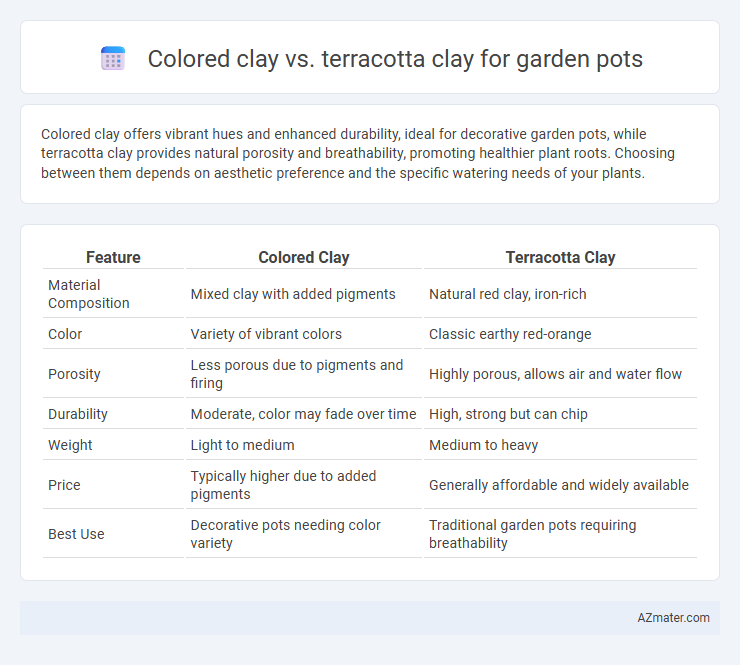Colored clay offers vibrant hues and enhanced durability, ideal for decorative garden pots, while terracotta clay provides natural porosity and breathability, promoting healthier plant roots. Choosing between them depends on aesthetic preference and the specific watering needs of your plants.
Table of Comparison
| Feature | Colored Clay | Terracotta Clay |
|---|---|---|
| Material Composition | Mixed clay with added pigments | Natural red clay, iron-rich |
| Color | Variety of vibrant colors | Classic earthy red-orange |
| Porosity | Less porous due to pigments and firing | Highly porous, allows air and water flow |
| Durability | Moderate, color may fade over time | High, strong but can chip |
| Weight | Light to medium | Medium to heavy |
| Price | Typically higher due to added pigments | Generally affordable and widely available |
| Best Use | Decorative pots needing color variety | Traditional garden pots requiring breathability |
Introduction to Colored Clay and Terracotta Clay
Colored clay offers a vibrant alternative to traditional terracotta clay with enhanced pigmentation that maintains durability and weather resistance for garden pots. Terracotta clay, made from natural earthenware, provides excellent porosity and breathability, promoting healthy root growth and moisture regulation in plants. Choosing between colored clay and terracotta clay depends on aesthetic preferences and specific gardening needs, balancing beauty with functionality.
Composition and Material Differences
Colored clay for garden pots typically consists of natural clay mixed with mineral pigments, offering a wide range of vivid hues and more consistent coloration due to balanced chemical compositions. Terracotta clay primarily contains iron oxide, giving it the classic reddish-brown color, and a porous texture that aids in water evaporation and root aeration. The material differences impact durability and porosity, with colored clays often glazed or treated to enhance water resistance, while terracotta remains more breathable but less water-repellent.
Visual Appeal and Aesthetics
Colored clay garden pots offer vibrant hues that enhance visual appeal and allow for customized aesthetics, complementing various garden styles and plant colors. Terracotta clay pots provide a natural, earthy look with warm reddish-brown tones that age gracefully, developing unique patinas over time. The choice between colored and terracotta clay ultimately depends on whether bold color accents or classic rustic charm best suit the garden's design.
Porosity and Drainage Capabilities
Colored clay pots generally exhibit lower porosity compared to terracotta clay, resulting in reduced natural breathability and slower moisture evaporation. Terracotta clay is highly porous, allowing superior drainage and air exchange, which prevents root rot and promotes healthier plant growth. For garden pots, terracotta's enhanced porosity and drainage capabilities make it preferable for plants requiring well-drained soil conditions.
Durability and Weather Resistance
Terracotta clay offers moderate durability with its porous nature, allowing for breathability but making it prone to cracking under extreme freeze-thaw cycles. Colored clay, often treated or glazed, provides enhanced weather resistance by reducing permeability and increasing surface hardness, which extends pot longevity in various climates. Both materials require appropriate care, but colored clay typically outperforms terracotta in resisting moisture absorption and environmental wear.
Weight and Handling Considerations
Colored clay garden pots generally feature a lighter weight compared to traditional terracotta clay, enhancing ease of handling and repositioning. Terracotta clay pots are denser and heavier, offering increased stability in outdoor environments but requiring more effort during transportation or rearrangement. Gardeners seeking portability benefit from colored clay, while those prioritizing durability and sturdiness often prefer terracotta options.
Cost Comparison
Colored clay garden pots generally cost more than terracotta clay pots due to the added pigments and manufacturing processes involved. Terracotta clay remains a popular, budget-friendly option as it is made from natural, uncolored clay that is abundant and easier to produce. The price difference can range from 10% to 40%, depending on the quality and brand of the garden pot.
Suitability for Plant Health
Colored clay pots often contain added pigments that may affect porosity, thereby influencing moisture retention and root aeration essential for plant health. Terracotta clay, known for its natural porous structure, allows air and water to pass through, promoting healthy root respiration and preventing overwatering. Choosing terracotta clay pots supports better drainage and helps maintain optimal soil conditions, which are crucial for the vigorous growth of most garden plants.
Environmental Impact and Sustainability
Colored clay pots often contain synthetic pigments and additives that may introduce harmful chemicals into the environment during production and disposal, reducing their overall sustainability. Terracotta clay, made from natural, porous red clay, is more eco-friendly due to its biodegradability and minimal processing requirements, resulting in a lower carbon footprint. The natural aeration and water permeability of terracotta pots also support healthier plant growth, contributing to sustainable gardening practices.
Choosing the Right Clay for Your Garden Pots
Colored clay offers vibrant aesthetics and added durability, making it ideal for decorative garden pots that stand out, while terracotta clay provides excellent breathability and natural insulation, promoting healthy root growth. Gardeners seeking long-lasting pots with enhanced color options should choose colored clay, whereas those prioritizing traditional, porous pots that regulate soil moisture may prefer terracotta. Selecting the right clay depends on balancing factors like visual appeal, plant health, and environmental conditions in your garden.

Infographic: Colored clay vs Terracotta clay for Garden pot
 azmater.com
azmater.com